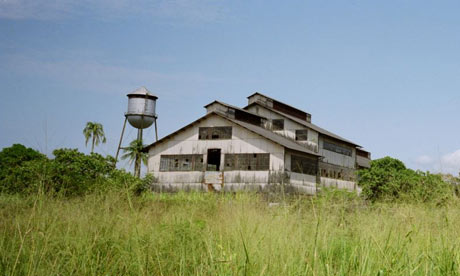
Moderators: Elvis, DrVolin, Jeff







So? What have your fantasies to do with the actually interesting and worthwhile and reality-based info in the OP?I did a whole post and thread about Disney's Dr. Haseltine going over to NSA to do Big Brother data mining.




IDEAS & TRENDS: UNBUILDING -- ARCHITECTURE; All Fall Down
By NICOLAI OUROUSSOFF
The ravaged neighborhoods of New Orleans make a grim backdrop for imagining the future of American cities. But despite its criminally slow pace, the rebuilding of this city is emerging as one of the most aggressive works of social engineering in America since the postwar boom of the 1950s. And architecture and urban planning have become critical tools in shaping that new order.
Nowhere is this more apparent than in the federal Department of Housing and Urban Development's plan to demolish four of the city's biggest low-income housing developments at a time when the city still cannot shelter the majority of its residents. The plan, which is being challenged in federal court by local housing advocates, would replace more than 5,000 units of public housing with a range of privately owned mixed-income developments.
Billed as a strategy for relieving the entrenched poverty of the city's urban slums, it is based on familiar arguments about the alienating effects of large-scale postwar inner-city housing.
But this argument seems strangely disingenuous in New Orleans. Built at the height of the New Deal, the city's public housing projects have little in common with the dehumanizing superblocks and grim plazas that have long been an emblem of urban poverty. Modestly scaled, they include some of the best public housing built in the United States.
So it's not surprising that many of its residents suspect a sinister agenda is at work here. Locked out of the planning process, they fear the planned demolitions are part of a broad effort to prevent displaced poor people from returning to New Orleans.
This demolition strategy is not new. It is part of a long-standing campaign to dismantle the nation's public housing system that began in the 1970s. That campaign was based on the valid belief that the concentration of the poor into segregated ghettos condemned them to a permanent cycle of poverty, crime and drugs. Specifically, it was directed at the large-scale postwar housing developments that became a fixture of American cities in the 1960s -- anonymous blocks of concrete housing, like Chicago's recently partially demolished Cabrini-Green, whose deadening uniformity seemed to strip the poor of their identity, reducing them to repetitive numbers in a vast bureaucratic machine.
The last few decades have witnessed the emergence of a new model for public housing: mixed-income developments whose designs are largely based on New Urbanist town-planning principles. Nostalgic visions of Middle America, they are marked by narrow pedestrian streets and quaint two-story houses with pitched roofs and covered porches. For HUD, they have become the default mode for rebuilding in New Orleans.
But if the sight of workers dynamiting an abandoned housing complex was a cause for celebration in Chicago's North Side, the notion is stupefying in New Orleans, whose public housing embodies many of those same New Urbanist ideals: pedestrian friendly environments whose pitched roofs, shallow porches and wrought iron rails have as much to do with 19th-century historical precedents as with late Modernism.
More specifically, they were inspired by local developments such as the 1850s Pontalba Apartments and late-19th ''Garden City'' proposals, whose winding tree-lined streets and open green spaces were seen as an antidote to the filth and congestion of the industrial city.
The low red-brick housing blocks of the Lafitte Avenue project, in the historically black neighborhood of Treme, for example, are scaled to fit within the surrounding neighborhood of Creole cottages and shotgun houses. To lessen the sense of isolation, the architects extended the surrounding street grid through the site with a mix of roadways and pedestrian paths. As you move deeper into the complex, the buildings frame a series of communal courtyards sheltered by the canopies of enormous oak trees. Nature, here, was intended to foster spiritual as well as physical well being.
That care was reflected in the quality of construction as well. Solidly built, the buildings' detailed brickwork, tile roofs and wrought-iron balustrades represent a level of craft more likely found on an Ivy League campus than in a contemporary public housing complex.
They would be almost impossible to reproduce in the kind of bottom-line developments that have become the norm.
In truth, the collapse of New Orleans' public housing system had less to do with bad design than with cynical government policies, which were rooted in the city's divisive racial politics. Up through the 1950s, residents of Lafitte were supported by a network of social services, from nursery schools financed by the Works Progress Administration to onsite medical care, adult education programs, Boy Scout groups and gardening clubs.
But as the middle class fled to the suburbs in the 1960s, these services were gradually stripped away, transforming entire areas of the inner city into ghettos for the black underclass.
By 2002, conditions had worsened to the point that the city of New Orleans agreed to turn control of its public housing over to HUD. Today, the richly landscaped gardens are gone. Many of the lawns have been paved over and replaced by basketball courts. Huge garbage bins, some with fading paintings of balloons, are scattered across decaying lots. Towering floodlights illuminate forbidding concrete pathways.
That neglect has now touched bottom in post-Katrina New Orleans. Most of the city's public housing was boarded up a few months after the storm -- long before most residents were able to claim their possessions or clean out their refrigerators. Many are now rat-infested. And while HUD has promised that anyone who comes back will be provided housing in the same neighborhood, those residents that have managed to return have had little voice about what their housing will be. (By comparison, the city has set up numerous town meetings to help homeowners decide how to rebuild their neighborhoods.)
The point is not that projects like Lafitte should be painstakingly restored to their original condition; nor are we likely to return to the same spirit of social optimism that created them any time soon. None of the projects rise to the level, say, of the best Modernist workers housing built in Europe in the 1920s, some of which were such refined architectural compositions that their apartments are now occupied by upper-middle-class sophisticates.
But they certainly rank above the level of much of the conventional middle-class housing being churned out today. And it is not difficult to imagine how a number of thoughtful modifications -- the addition of new buildings, extensive landscaping, extending the existing street grid to anchor the project more firmly into the city -- could transform the project into model housing.
Yet HUD has never seriously considered such a plan. And although HUD says it has studied what it would cost to restore the projects, it has not released any figures. Finally, it has been unwilling to acknowledge the psychic damage of ripping out more of the city's fabric at a time when New Orleans has yet to heal the wounds of Hurricane Katrina.
HUD officials say they have not yet set a date for demolition, but they have already selected a team of developers -- Enterprise Community Partners and Providence Community Housing, an arm of the Catholic church -- which are working on plans for the site. Meanwhile, HUD's vision of the future is already visible several miles away at the New Fischer development in Algiers. Built to replace a decaying 1960s-era housing complex, part of which is still under demolition, the neighborhood's rows of two-story houses, painted in cheery pastel colors, will be occupied by a mix of low- and middle-income families. Its porch-lined streets are straight from a Norman Rockwell painting of small-town America.
But in many ways, the development is also an illusion. Conceived as an internalized world, with the majority of its narrow streets dead-ending into nowhere, the development is virtually cut off from the lifeblood of the surrounding city -- the shops, streets, parks and freeways that weave the city into an urban whole. And its uniform rows of houses represent a vision of conformity that has little to do with urban life. Instead, it replaces one vision of social isolation with another.
In its broadest sense, that approach is part of the continued assault against cities as places of contact and friction, where life is embraced in its full range. By smoothing over differences, it seeks to make the city safe for returning suburbanites and tourists.
This is a fool's game. The challenge in New Orleans is to piece together the fragments of a shattered culture.
Sadly, HUD's plan manages to trivialize the past without engaging the painful realities that have shorn this city apart.
MinM wrote:JUAN GONZALEZ: He introduced square dancing to replace the samba.
Users browsing this forum: No registered users and 4 guests